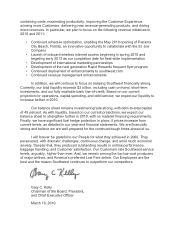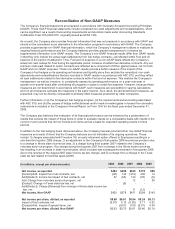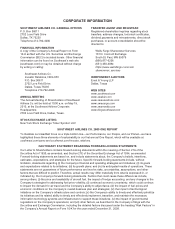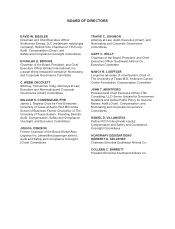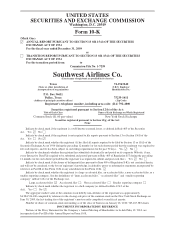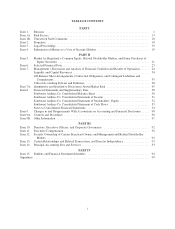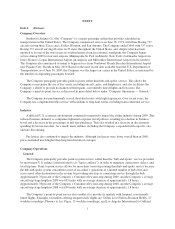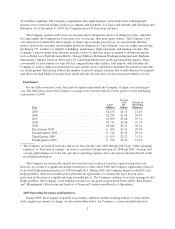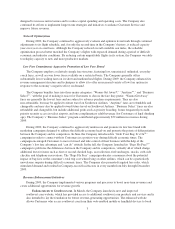Southwest Airlines 2009 Annual Report Download - page 13
Download and view the complete annual report
Please find page 13 of the 2009 Southwest Airlines annual report below. You can navigate through the pages in the report by either clicking on the pages listed below, or by using the keyword search tool below to find specific information within the annual report.Virtual Hold Customer Service Call Back Capabilities. The Company has also added a “virtual hold”
callback capability to its Customer Service capabilities. Customers who are waiting to speak to a Company
representative on the Company’s toll-free number may elect to hang up the phone, keep their place in the
queue, and receive a callback when a representative is available.
Automated Outbound Messaging. The Company has also completed implementation of Automated
Outbound Messaging, which has enabled the Company to proactively (i) contact Customers via phone to
inform them of cancelled or delayed flights and gate changes and (ii) give Customers the option to connect
to a Customer Representative in the case of cancelled flights.
Cost-Cutting Initiatives
During 2009, the Company continued its efforts to mitigate cost pressures. The Company addressed costs
through the strategic capacity cuts and network optimization discussed above, as well as through other cost
reduction and process improvement initiatives.
Employee Actions. In April, the Company launched a voluntary early-out program, “Freedom ’09,”
that was accepted by 1,404 Employees. Under the program, the Company offered cash bonuses, medical/
dental coverage for a specified period of time, and travel privileges based on work group and years of
service. The purpose of the program was to right-size headcount in conjunction with the Company’s
decision to reduce its capacity, as well as to reduce costs in subsequent years. Virtually all of the Company’s
Employees hired before March 31, 2008, were eligible to participate. The Company also implemented a
freeze on overall headcount and a salary freeze for senior management.
Reduced Capital Expenditures and Cost Reductions. The Company materially reduced its capital
spending in 2009 by deferring new aircraft deliveries into future years, as well as by reducing non-strategic,
non-aircraft spending.
Winglets. In 2009, the Company completed the installation of Aviation Partners Boeing Blended
Winglets on a total of 21 of its 737-300 aircraft (all 737-700 aircraft have already been equipped with
winglets). The winglets are designed to reduce drag and increase fuel efficiency.
Required Navigational Performance. In December 2009, the Federal Aviation Administration (the
“FAA”) approved the Company’s Airlines Operation Specification, which will allow the Company to fly
GPS (Global Positioning System) approach procedures beginning in second quarter 2010. GPS approaches
use GPS space-based navigation (GPS satellites) instead of ground-based navigation aids. This will enable
aircraft to carry navigation capabilities rather than relying on airports. It will also improve operational
capability by opening up many new and more direct approach paths and creates the necessary foundation for
future Required Navigation Performance (RNP) operations. The Company expects to complete its RNP
training and begin RNP operations by the end of 2010. RNP is one of the cornerstones for the FAA’s Next
Generation Air Traffic Control System and combines GPS, the capabilities of advanced aircraft avionics,
and new flight procedures for the purpose of achieving safer, more efficient, and environmentally friendly
flight operations. RNP procedures are designed to conserve fuel, improve safety, and reduce carbon
emissions, while simultaneously taking advantage of the high-performance characteristics that exist in an
airline’s fleet. The Company has already activated autothrottles and VNAV (vertical navigation) on its
aircraft, which is providing current benefits such as fuel savings and reduced carbon emissions.
Rapid Rewards Frequent Flyer Program
The Company offers a frequent flyer program, Rapid Rewards, which allows Customers to earn credits
towards free flights based on trips flown. Rapid Rewards Members can earn a credit for each one-way trip flown
or two credits for each roundtrip flown. They can also earn credits by using the services of non-airline “Preferred
Partners,” which include, for example, car rental agencies, hotels, restaurants, and retail locations, as well as by
using the Southwest Airlines Rapid Rewards Visa Signature Card.
5


